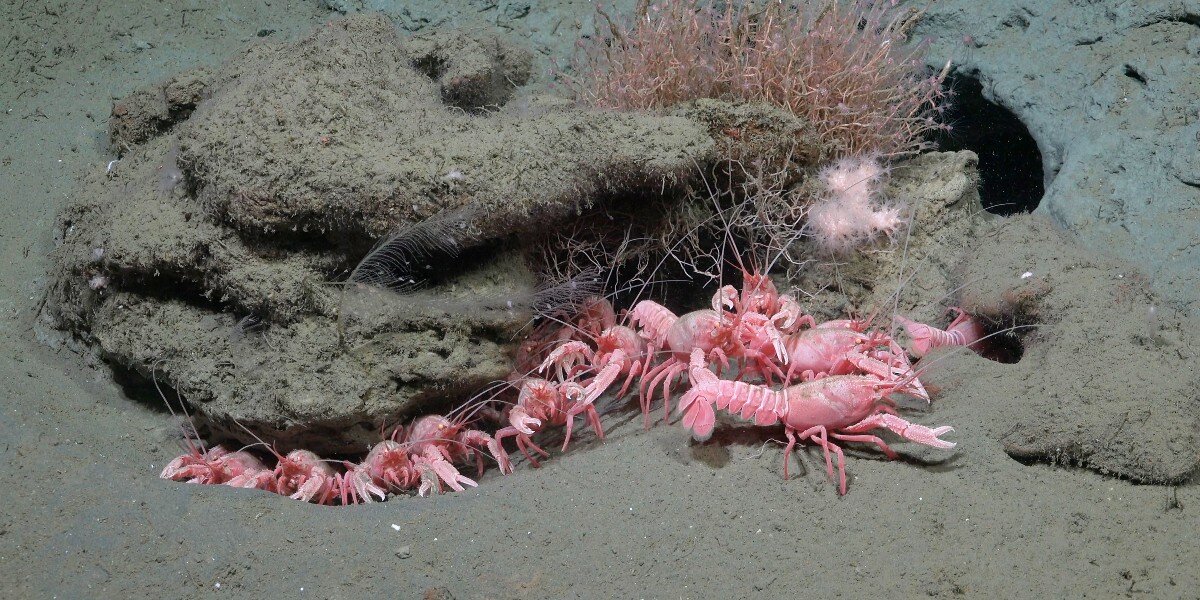A few months ago, scientists at the Schmidt Ocean Institute sent a remotely operated vehicle called ROV SuBastian 2 miles down into the ocean to observe deep-sea wildlife. The scientists’ goal was to learn about the species living at the bottom of the Mar Del Plata Canyon, located off the coast of Argentina.
At 11,483 feet deep, the Mar Del Plata Canyon is twice as deep as the Grand Canyon. Before the Schmidt Ocean Institute’s expedition, no one had been able to observe what was at the bottom of the trench, so the scientists weren’t sure who they’d find living there.
When the researchers first saw the live footage from ROV SuBastian, they were blown away. The world at the bottom of the canyon was almost entirely pastel pink. There were vast pink coral fields, pink sea stars and even pink octopuses.
 ROV SuBastian / Schmidt Ocean Institute (CC BY-NC-SA 4.0)
ROV SuBastian / Schmidt Ocean Institute (CC BY-NC-SA 4.0)
Over the course of the three-week expedition, the researchers observed over 40 new-to-science species and got a close look at some incredibly rare, unique species. Among them were these bubblegum-colored lobsters.
 ROV SuBastian / Schmidt Ocean Institute (CC BY-NC-SA 4.0)
ROV SuBastian / Schmidt Ocean Institute (CC BY-NC-SA 4.0)
“[W]e suspect they are Thymops birsteini, or Patagonian lobsterette — crustaceans found on the continental shelf around South America, particularly in the Argentine Sea,” the Schmidt Ocean Institute wrote on Instagram.
Scientists have only seen pink Patagonian lobsterettes a handful of times before, and have never gotten to observe them this closely before. The researchers watched as a group of a dozen or so lobsters gathered together around a rock.
“While little is known about these animals, they resemble a typical lobster with two large claws, four other pairs of walking legs that can be used to gather food called pereiopods, and a long tail, which is called a pleon,” the Schmidt Ocean Institute wrote.
The bright pink lobsters have captured the imaginations of the many people who’ve seen a picture or video of them.
“They’re pink because they’re Barbie’s lobsters,” a commenter wrote below Schmidt Ocean Institute’s Instagram post.
As delightful as the lobsters’ coloring is, there’s actually a biological reason for their unique hue. In the photos captured by ROV SuBastian, the lobsters stand out against the canyon’s gray silt. But in reality, their pink shells actually help them camouflage — reds and pinks appear black in the deep ocean because the water absorbs red light wavelengths.
 ROV SuBastian / Schmidt Ocean Institute (CC BY NC-SA 4.0)
ROV SuBastian / Schmidt Ocean Institute (CC BY NC-SA 4.0)
More research is needed to learn more about the many creatures captured on camera by the ROV SuBastian. Unfortunately, though, the fragile deep-sea ecosystem is under threat. The scientists observed plastic bags and other debris at the bottom of the canyon, which serves as a great reminder to protect the ocean so we can continue learning more about these unique animals.
“Deep-sea canyons are biodiversity hotspots and play key roles in ecosystem functioning, yet we still know very little about them,” Jonathan Flores, a researcher at the National Scientific and Technical Research Council in Argentina, told Scientific American.
 Fisherman Catches Extremely Rare Bright Blue LobsterHe’s one in two million!
Fisherman Catches Extremely Rare Bright Blue LobsterHe’s one in two million!
